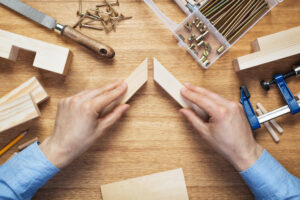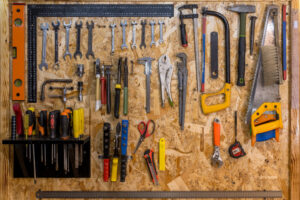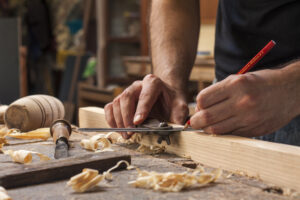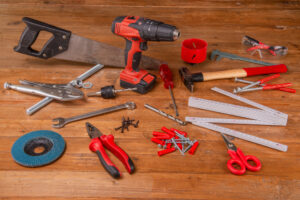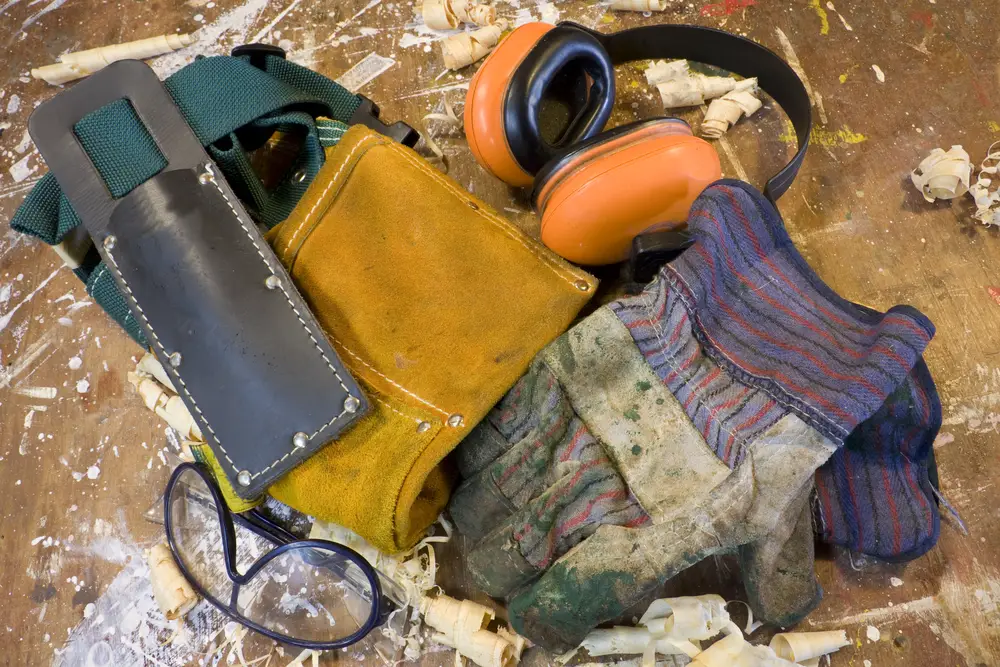
Working on DIY carpentry projects can be a rewarding experience, but it’s important to prioritise safety. By following these basic carpentry safety tips, you can ensure that your DIY projects are both successful and injury-free.
Key Takeaways
- Invest in proper safety gear such as goggles, gloves, ear protection, and work boots.
- Read the instructions and use tools correctly to prevent accidents.
- Maintain your tools in good condition and replace any broken or damaged ones.
- Create a safe workspace by keeping it clean and free of hazards.
- Use supports like sawhorses to stabilize materials and use guards and guides on power tools.
Wear the proper safety gear
When it comes to carpentry, safety should always be a top priority. One of the most important carpentry safety tips is wearing the right safety gear. Proper safety equipment can significantly reduce the risk of injuries while working on DIY woodworking projects. Here are some essential items of carpentry safety equipment that you should consider:
- Goggles: Protect your eyes from flying debris, dust, and other potential hazards while working with tools or materials. Brand: 3M Safety Glasses
- Gloves: Keep your hands safe from cuts, abrasions, and splinters. Choose gloves that provide a good grip and allow freedom of movement. Brand: Ansell HyFlex Work Gloves
- Ear protection: Carpentry tools can generate loud noise levels that can cause long-term hearing damage. Use earplugs or earmuffs to reduce the risk. Brand: 3M Earmuffs
- Work boots: Protect your feet from falling objects, sharp tools, and potential electrical hazards. Choose boots with slip-resistant soles and safety toe caps. Brand: Timberland Pro Men’s 6″ Pit Boss Soft Toe Work Boot
Depending on the specific task at hand, you may need additional specialized gear. For example, when painting, use a respirator to protect yourself from harmful fumes, or when cutting wood with a chainsaw, wear chainsaw safety gear to shield against potential kickback accidents. Don’t forget to tie back long hair and avoid wearing loose-fitting clothing that can get caught in machinery.
Investing in quality safety gear may seem like an additional expense, but it’s a small price to pay for your well-being. By wearing the proper carpentry safety equipment, you can significantly reduce the risk of injuries and enjoy your DIY woodworking projects with peace of mind.
Use tools properly and maintain them
When it comes to carpentry, using your tools correctly is paramount for ensuring safety and preventing accidents. Take the time to read the instructions and familiarize yourself with the proper techniques for each tool you use. This will not only help you work more efficiently but also reduce the risk of injuries.
Additionally, maintaining your tools in good working condition is essential for safe woodworking practices. Regularly check for any damage or wear that could compromise their performance or safety. Replace any broken or damaged tools before starting a project.
Respecting and caring for your hand tools is equally important to carpentry safety rules. By keeping them clean, sharp, and properly stored, you can extend their lifespan and ensure they always function optimally.
Commonly used carpentry tools and maintenance tips
| Tool | Maintenance Tips |
|---|---|
| Saw | Regularly clean blades, oil moving parts, and replace dull blades. |
| Chisel | Sharpen blades as needed and store in a protective case. |
| Hammer | Periodically check for loose or damaged handles and replace if necessary. |
| Screwdriver | Ensure the tip is in good condition and use the appropriate size for each screw. |
| Measuring tape | Keep the tape clean and free of debris, and replace if it becomes damaged. |
By following these safe woodworking practices and carpentry safety rules, you can minimize the risk of accidents and create a secure working environment for yourself. Remember, properly using and maintaining your tools is essential for staying safe while enjoying the art of carpentry.
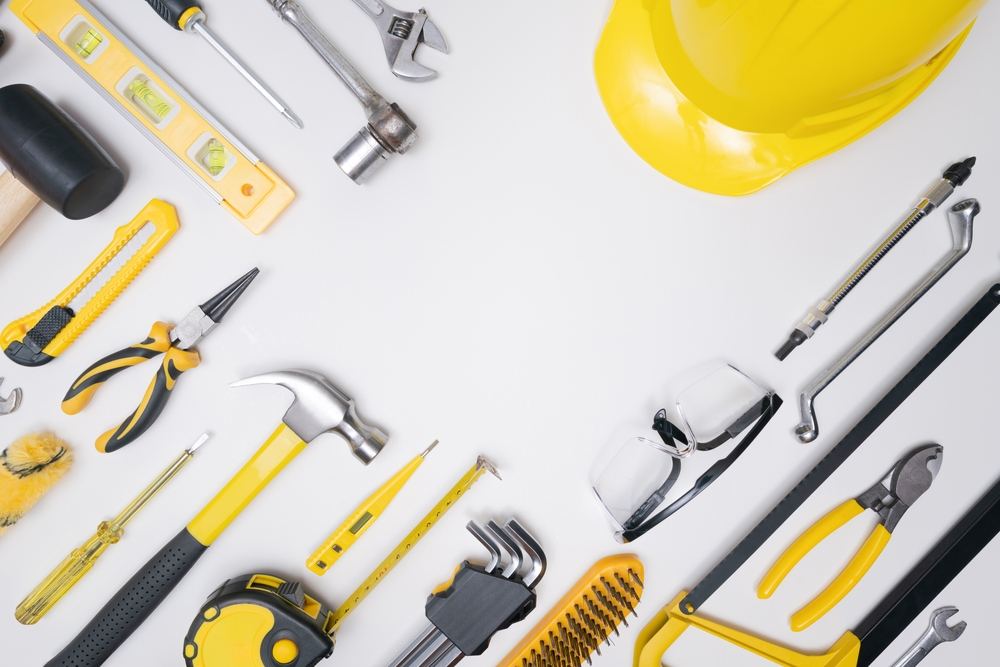
Practice good workspace safety
Creating a safe workspace is essential for carpentry safety. To ensure a secure working environment, it is important to follow these carpentry safety guidelines:
- Maintain good footing: Keep your workspace clean and free from hazards, such as clutter, spills, or obstacles, to maintain stable footing.
- Stabilize materials: Use sawhorses or other supports to stabilize materials you are working with to prevent slipping or falling.
- Organize tools: Keep your tools organized and put them away when not in use. This will prevent them from becoming hazards and reduce the risk of accidents.
- Follow safety instructions: Use guards and guides on power tools as instructed by the manufacturer. This will help prevent injuries and ensure safe operation.
By practising good workspace safety, you can significantly reduce the risk of accidents and injuries while carpentering. Keeping a clean and organized workspace, using appropriate supports, and following safety instructions will create a secure environment for your carpentry projects.
Conclusion
DIY carpentry projects can be a fulfilling and practical way to improve your home. By prioritising safety and following these basic carpentry safety tips, you can enjoy your projects while reducing the risk of injury. Remember to wear the proper safety gear, use tools correctly, maintain a safe workspace, and take your time to complete tasks safely. With these guidelines in mind, you can confidently tackle DIY carpentry projects and create something amazing.
When it comes to carpentry safety, it’s crucial to invest in the right safety equipment. Ensure you have goggles to protect your eyes, gloves to safeguard your hands, ear protection to preserve your hearing, and sturdy work boots for foot protection. Don’t forget to tie back long hair and avoid loose-fitting clothing that can get caught in machinery.
Furthermore, using tools properly and maintaining them is essential for carpentry safety. Always read the instructions and familiarise yourself with the correct techniques for each tool. Regularly inspect your tools for any damage or wear that could compromise their safety or performance. Replace any broken or damaged tools before starting a project.
Creating a safe workspace is another crucial aspect of carpentry safety. Keep your workspace clean and free of hazards such as clutter, spills, or obstacles. Use sawhorses or other supports to stabilize materials and prevent slipping or falling. Organize your tools and always follow safety instructions provided by the manufacturer regarding guards and guides for power tools.
FAQ
Why is wearing the right safety gear important in carpentry?
Wearing the proper safety gear, such as goggles, gloves, ear protection, and work boots, is crucial in carpentry to protect yourself from potential injuries. It is also important to tie back long hair and avoid wearing loose-fitting clothing that can get caught in machinery.
How can I ensure I am using my tools correctly for carpentry projects?
To prevent accidents, make sure you read the instructions and familiarize yourself with the proper techniques for each tool. It is also important to ensure that your tools are in good working condition by checking for any damage or wear. Replace any broken or damaged tools before starting a project.
How can I create a safe workspace for carpentry projects?
To maintain a safe workspace, keep it clean and free of hazards such as clutter, spills, or obstacles. Use sawhorses or other supports to stabilize materials and prevent slipping or falling. Keep your tools organized and put them away when not in use. Additionally, use guards and guides on power tools and follow all safety instructions provided by the manufacturer.
What are some basic carpentry safety guidelines for DIY projects?
When working on DIY carpentry projects, prioritize safety by wearing the proper safety gear, using tools correctly, and maintaining a safe workspace. Take your time to complete tasks safely and avoid rushing the job.
- Drill Battery Maintenance: Essential Tips for Cordless Drill Battery Care - February 5, 2024
- Troubleshooting Drill Issues - February 5, 2024
- Quick Drilling Techniques - February 2, 2024

